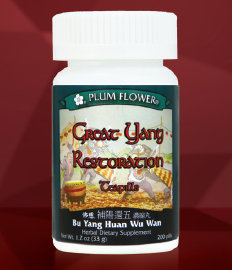Great Yang Restoration Teapills - Bu Yang Huan Wu Wan

TCM Functions: Toni es the Qi, Invigorates the Blood, Unblocks the Channels and Collaterals.
TCM Diagnosis: Recovery from internal wind-strike in patients with Qi or Yang de ciency and Blood stasis.
Presentation: occasional slurred speech and other speech di culties, excessive salivation or drooling, low and soft voice, breathlessness; occasional fatigue or exhaustion, listlessness, muscular weakness; pale purplish complexion & lips, cold intolerance, sweating easily, occasional dry stools, urinary frequency.
Tongue: varied; usually pale purplish with a white coat.
Pulse: varied; usually including moderate or thready.
Ingredients: Huang qi/Astragalus membranaceus root 83.4%, Chi shao/Paeonia lacti ora root 4.2%, Dang gui/Angelica sinensis root 4.2%, Chuan xiong/Ligusticum chuanxiong rhizome 2.1%, Tao ren/Prunus persica seed 2.1%, Hong hua/Carthamus tinctorius ower 2%, Di long/Pheretima aspergillum 2%.
Dosage & Administration: The standard dosage is 8 pills, 3 x day. In severe cases or in the initial phases of treatment, dosage may be increased to 12-15 pills 3 times per day, then reduced to a maintenance dose as the treatment takes e ect. Administer 1/2 hour before or 1 hour after eating for optimal digestion & absorption. Use consistently from 2 weeks after internal wind-strike for a minimum of several months. May be used long-term for several years. To facilitate swallowing, soften pills with a small amount of boiling water and then mash to a thick liquid after 10-15 minutes.
Cautions & Contraindications: Contraindicated during pregnancy. Contraindicated during the rst two weeks following an internal wind-strike, or for patients with a large, forceful, wiry pulse. Use with caution in hypertension as Huang qi/astragalus may raise blood pressure in some cases. Contraindicated with hemorrhagic disorders. Use with caution in patients on anticoagulant therapy or for women during heavy menstrual bleeding. Use with caution in Yin de ciency. Contraindicated during the early stages of acute infection or illness, such as cold or u.
Clinical Comments: From Dr. Wang Qing-Ren’s formula book, Correcting the Errors in the Forest of Medicine, published in 1830. Bu Yang Huan Wu Wan is primarily indicated to support recovery from an internal wind-strike, especially when the patient both su ers from di culty regaining function in the body and head, and experiences great exhaustion. A wind-strike is the result of the chaotic and unruly movement of wind; usually due to a background combination of de ciency and excess that eventually tips over into an acute episode of either external or internal wind attacking the head and bringing up some combination of excess phlegm, re Liver Yang rising and/or Blood stagnation, leaving signi cant blockages in its wake. When half of the body is a ected afterwards due to extreme Qi/Yang de ciency causing Blood stagnation that prevent the Yang Qi from owing on that side, this formula is indicated. The formula’s name translates to “Tonify Yang to Restore Five Tenths” which alludes to its ability to restore the function to the a ected half of the body. Dr. Wang Qing-Ren’s unique formula was designed to primarily strengthen the Qi in order to move the Blood, and secondarily to directly invigorate the Blood and open the channels and collaterals, thus promoting healthy muscular and neural function and response.
It helps engender normal circulation and sensation, particularly in the lower limbs, where it can help mitigate the side e ects of many disorders associated with weakness or loss of sensation of peripheral muscles, as well as for supporting patients with loss of sensation. It also has an a nity for the face and is frequently used to support the long-term recovery phases of wind attacking the face leading to Qi and Yang de ciency, such as wind attacking the jaw or trigeminal nerve. The chief herb, Huang qi/Astragalus root makes up over 80% of the formula. Huang qi strongly toni es the Yuan-source Qi to help the body recover as well as raising the Yang Qi to the head, external surface of the body and out to the extremities, where repair is needed. Once the Qi is su cient, it is able to promote the free ow of Blood, indirectly eliminating Blood stasis and supporting the healthy function of the body’s muscles and nerves. Dang gui aids Huang qi by directly invigorating the Blood, as well as tonifying Blood to nourish the newly unblocked channels and collaterals. Normal movement of Qi and Blood also expels any remnants of external wind. Dang gui combines with Chuan xiong, Chi shao, Hong hua and Tao ren to strongly invigorate the Blood, disperse stasis, open blockages in the blood vessels and expel wind, all without causing further damage. A small dose of Di long is used to aid both Huang qi and the blood moving herbs by dredging the meridians to eliminate stagnation and facilitate the movement of Qi to all areas of the body. Di long is an important herb to restore normal physical function to blocked areas by calming the Liver and extinguishing wind, and with its moving and piercing ability. It is said to “dredge” or powerfully open the channels and collaterals by “worming its way” through them.
References:
- The Clinical Manual of Chinese Herbal Patent Medicines, 3rd Edition, by Will Maclean with Kathryn Taylor, Pangolin Press, 2016.
- Chinese Herbal Medicine - Formulas and Strategies, 2nd Edition, by Dan Bensky, Volker Scheid, Andrew Ellis and Randall Barolet,Eastland Press, 2009.
- Chinese Herbal Medicine – Materia Medica, 3nd Edition, by Dan Bensky, Steven Clavey and Erich Stoger, with Gamble, Eastland Press, 2004.
- Chinese Herbal Formulas and Applications - Pharmacological E ects & Clinical Research, by John Chen & Tina Chen, Art of Medicine Press, 2009.
- Chinese Medical Herbology and Pharmacology, by John Chen & Tina Chen, Art of Medicine Press, 2004.
- Essential Chinese Formulas – 225 Classical and Modern Prescriptions, by Jake Fratkin, Shya Publications, 2014.
- 160 Essential Chinese Herbal Patent Medicines, by Bob Flaws, Blue Poppy Press, 1999.
- Chinese Patent Medicines, A Beginner’s Guide, by Mark Taylor, Global Eyes International Press, 1998.


